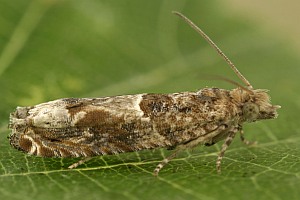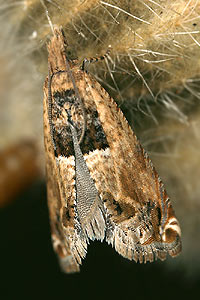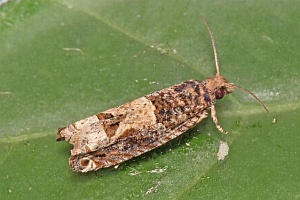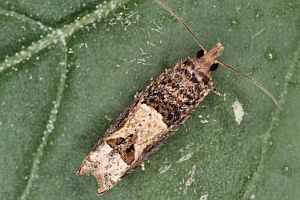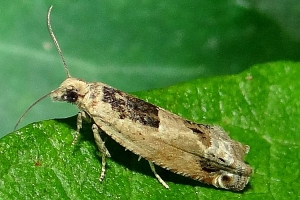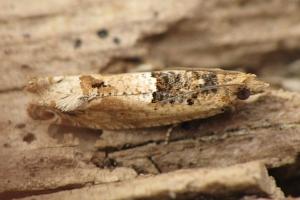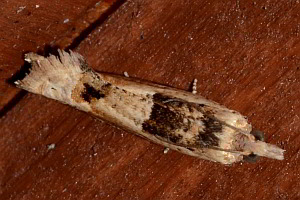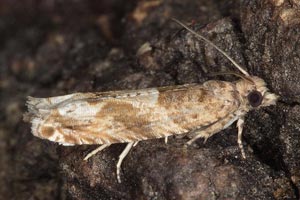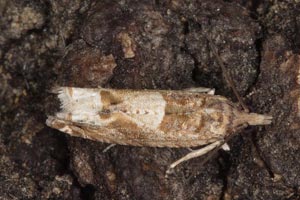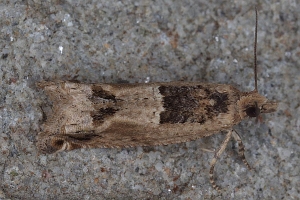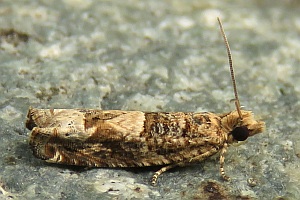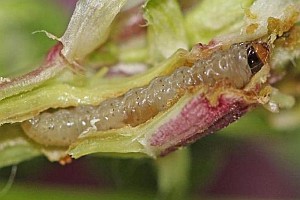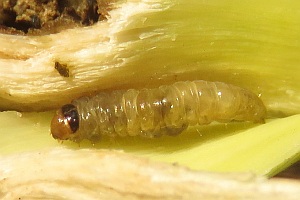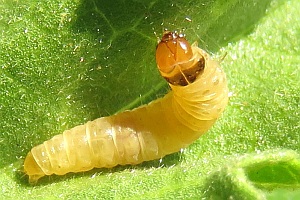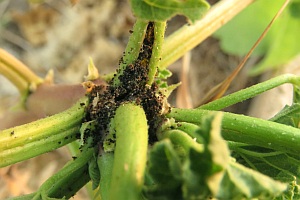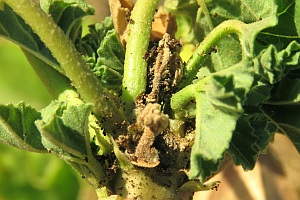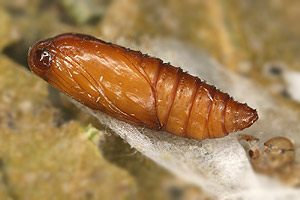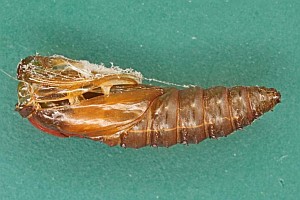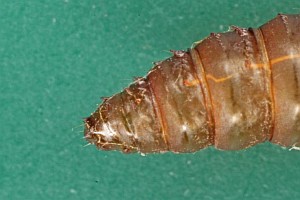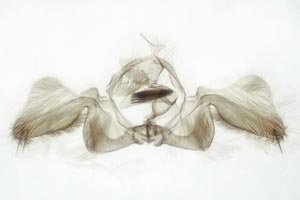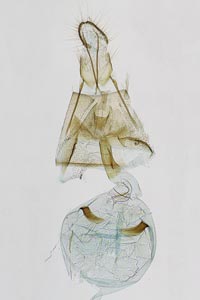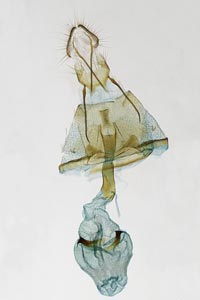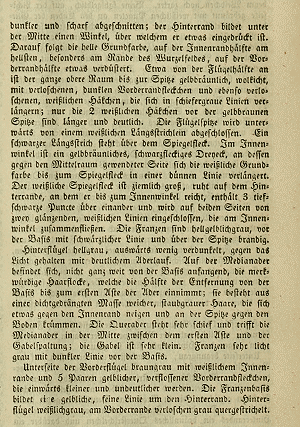
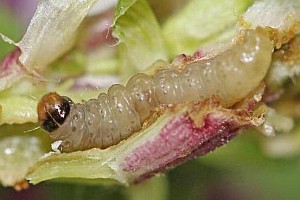
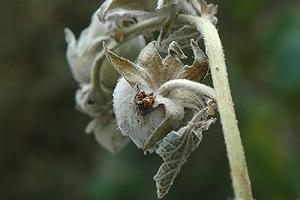
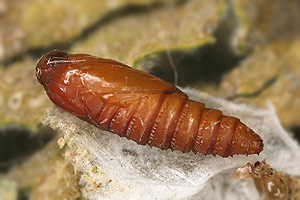
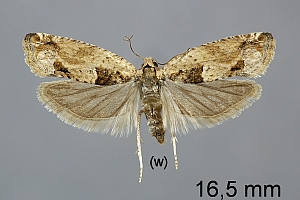
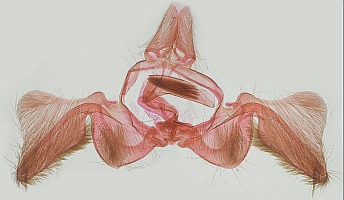
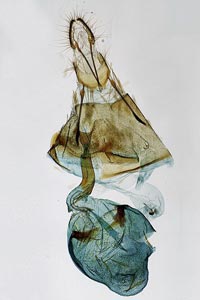
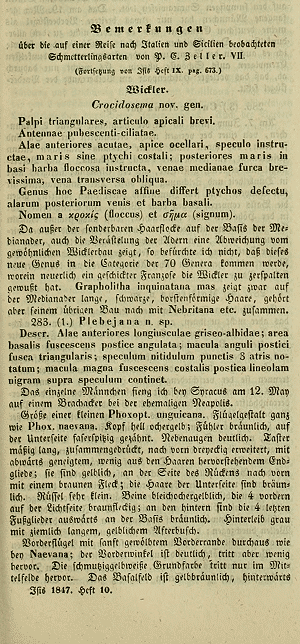
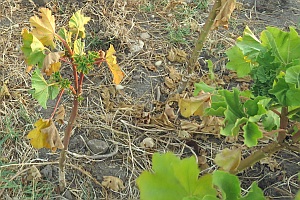
1. Lebendfotos
1.1. Falter
1.2. Raupe
1.3. Fraßspuren und Befallsbild
1.4. Puppe
2. Diagnose
2.1. Männchen
2.2. Genitalien
2.2.1. Männchen
2.2.2. Weibchen
2.3. Erstbeschreibung
3. Biologie
3.1. Raupennahrungspflanzen
3.2. Nahrung der Raupe
- [Malvaceae:] Malva sylvestris (Wilde Malve) [(auch) Europa]
- [Malvaceae:] Malva parviflora (Kleinblütige Malve) [(auch) Europa]
- [Malvaceae:] Malva moschata (Moschus-Malve) [(auch) Europa]
- [Malvaceae:] Malva arborea [= Lavatera arborea] (Baumförmige Strauchpappel) [(auch) Europa]
- [Malvaceae:] Alcea rosea [= Althaea rosea] (Gewöhnliche Stockrose) [(auch) Europa]
- [Malvaceae:] Althaea sp. (Stockrose) [(auch) Europa]
- [Malvaceae:] Abutilon sp. (Schönmalve)
- [Malvaceae:] Hibiscus furcellatus
- [Malvaceae:] Hibiscus laevis
- [Malvaceae:] Hibiscus rosa-sinensis (Chinesischer Rosen-Eibisch, Zimmer-Hibiskus)
- [Malvaceae:] Hibiscus sp. (Eibisch, Hibiskus)
- [Malvaceae:] Gossypium herbaceum (Baumwolle)
- [Malvaceae:] Gossypium hirsutum (Hochland-Baumwolle, Wilde Baumwolle)
- [Malvaceae:] Gossypium sp. (Baumwolle)
- [Malvaceae:] Abelmoschus esculentus (Okra)
- [Malvaceae:] Melochia corchorifolia [= Riedlea corchorifolia]
- [Malvaceae:] Sida cordifolia (Sandmalve, Indische Malve)
- [Malvaceae:] Sida acuta
- [Malvaceae:] Sida spinosa
- [Malvaceae:] Anoda cristata (Anoda-Malve)
- [Malvaceae:] Malvastrum americanum
- [Malvaceae:] Malvaviscus arboreus (Beerenmalve)
- [Rosaceae:] Crataegus sp. ??? (Weißdorn ???) [(auch) Europa]
- [Passifloraceae:] Turnera ulmifolia ???
- [Amaranthaceae:] Atriplex limbata ???
- [Cucurbitaceae:] Cucurbita pepo ??? (Gartenkürbis ???)
- [Myrtaceae:] Eucalyptus sp. ??? (Eukalyptus ???)
- [Fabaceae:] Phaseolus lunatus ??? (Lima-Bohne ???)
- [Vitaceae:] Vitis vinifera ??? (Weinrebe ???)
- [Poaceae:] Triticum sp. ??? (Weizen ???)
Die Raupe lebt an verschiedenen Malvengewächsen und dort vornehmlich an deren Samen. Angaben zu anderen Pflanzenfamilien sind durchweg fraglich.
Disqué (1901: 176) teilt mit: "Einen F. dieser südlichen Art erzog ich vor Jahren aus Malvensamen und wurde mir von Eppelsheim - Grünstadt, der ihn auch erzogen hatte, bestimmt."
Kennel (1916: 469) schrieb knapp: "Die Raupe lebt im Juli und im September, Oktober in den Samen von Althaea rosea und Malva sylvestris".
Schütze (1931) trägt zusammen: "Raupe September bis Frühjahr. Einen Falter dieser südlichen Art erzog ich im September an den Samen von Malva sylvestris, und Eppelsheim einige Stücke im Juli und Oktober an den Samen der Gartenmalve (Althaea rosea) (Disqué). Lavatera (Spuler). Süddeutschland."
Nach der Zusammenstellung von Hancock et al. (2015: 125) werden eine Vielzahl von Malvengewächsen belegt: "Ovum. Laid in July - September on tree-mallow (Lavatera arborea). Abroad it is associated with various Malvaceae, including species of Lavatera, Althaea, Malva, Abutilon, Hibiscus, Gossypium and also hawthorn (Crataegus spp.)." Zur Raupe haben sie Interessantes mitzuteilen: "August - October; feeds on the seeds in the seed capsule or occasionally in the shoots of tree-mallow; moves from one capsule to another, to holes in a capsule usually indicating that the larva has left (Huggins & Mere, 1958); in Portugal it has been found feeding in the rootstock of Lavatera and Malva in September and was thought to do so when seeds are not available (Corley, 1992)."
Die Angabe zu Crataegus (Rosaceae) findet sich auch schon bei Razowski (2001: 78) - sie dürfte falsch sein, allerdings werden von außerhalb Europas auch noch andere Eurosiden genannt.
Auf [cabi.org (abgefragt 23. November 2019)] ist zu erfahren: "The biology and ecology of C. plebejana have been studied in Australia, where it is a minor to occasionally serious pest of seedling cotton in southern Queensland and New South Wales (Bishop and Blood, 1978; Hamilton and Gage, 1986; Hamilton and Zalucki, 1991, 1993a, b). However, there seems to have been no detailed study of the life cycle independent of the cotton-growing season or in other regions." Und: "Hence, it would be possible for 10 or 12 generations to be completed annually under optimum conditions, but probably no more than three to five generations are realized in most temperate and subtropical regions. In Queensland, Hamilton and Zalucki (1991) suggest that three to five generations are possible on cotton (Gossypium spp.) annually, but only one occurs." Nach den Ausführungen ist Baumwolle als Nahrungspflanze nur bedingt geeignet, spielt also eine eher untergeordnete Rolle als Raupennahrung. Aber: "Evidently C. plebejana is very successful at spreading on its own in association with weeds, especially Malva parviflora, and by the movement of nursery stock, such as hollyhock (Alcea rosea)." Die Liste befallener Pflanzen auf [cabi.org (abgefragt 23. November 2019)] ist sehr lang. Sie enthält neben Nutzpflanzen und Wildkräutern der Familie Malvaceae auch noch eine ganze Reihe von Pflanzen ganz anderer Familien, deren reale Nutzung durch C. plebejana aber mit großen Fragezeichen zu versehen ist.
(Autor: Erwin Rennwald)
4. Weitere Informationen
4.1. Synonyme
- Penthina altheana Mann, 1855
- Paedisca lavaterana Millière, 1863
- Grapholitha peregrinana Möschler, 1866
- Steganoptycha obscura Wollaston, 1879
- Proteopteryx blackburnii Butler, 1881
- Crocidosema plebeiana Meyrick, 1881
- Grapholitha excitana Möschler, 1891
- Crocidosema ptiladelpha Meyrick, 1917
- Crocidosema insulana Aurivillius, 1922
- Eucosma charmera Turner, 1946
- Eucosma tornocycla Turner, 1946
- Crocidosema iris Diakonoff, 1984
- Crocidosema bostrychodes Diakonoff, 1992
4.2. Taxonomie
Huemer (2016: 9) stellt nach Molekularuntersuchungen fest: „Die Art ist im Barcode mit drei BINs ausgesprochen divergent, ein Hinweis auf mögliche kryptische Arten. Tiere aus Kreta clustern gemeinsam mit allen anderen europäischen Proben.“ Möglicherweise müssen also auch die Angaben zur weltweiten Verbreitung der Art und zu den Nahrungspflanzen der raupen noch einmal revidiert werden.
4.3. Faunistik
Huemer (2016: 9) stellt nach Molekularuntersuchungen fest: „Die Art ist im Barcode mit drei BINs ausgesprochen divergent, ein Hinweis auf mögliche kryptische Arten. Tiere aus Kreta clustern gemeinsam mit allen anderen europäischen Proben.“
C. plebejana wurde von Syrakus auf Sizilien (Italien) beschrieben. Mit ziemlicher Sicherheit wurde sie dort aber eingeschleppt, mit einiger Wahrscheinlichkeit aus Südamerika. Auf [cabi.org (abgefragt 23. November 2019)] ist dazu zu erfahren: "The geographic origin of C. plebejana is unknown, but is suspected to be South America, based on the occurrence of other Crocidosema species (Meyrick, 1917 and citations therein; Fletcher, 1932; Powell et al., 1995). Owing to the variation among populations of the Pacific Islands (Clarke, 1971, 1976, 1986; Zimmerman, 1978), that region is a possible evolutionary source of plebejana too. In any case, the species was first discovered at the port of Syracuse on the south coast of Sicily (Zeller, 1847), where it presumably had already been introduced by shipping. By the late nineteenth century it had become established pan-globally in warmer regions, having been recorded in France (Milliere, 1863), the South Pacific islands (Meyrick, 1886), the West Indies (Walsingham, 1897), the south coast of England by 1900 (Bradley et al., 1979), and the Canary Islands in 1907 (Walsingham, 1908)."
Emmerson & Hoare (2019: 59) listen die Art als "Native" von Albany (Auckland, Neuseeland): "Uncommon; recorded from December until February." - Insgesamt spricht hier aber doch mehr dafür, dass die Art hier schon früh eingeschleppt wurde.
In Deutschland sind die Funde dieser tropisch-subtropisch verbreiteten Art bisher recht spärlich und weitgehend auf den Süden beschränkt (Bayern, Baden-Württemberg, Rheinland-Pfalz, Saarland, Nordrhein-Westfalen, Brandenburg).
(Autor: Erwin Rennwald)
4.4. Literatur
- Arenberger, E. & J. Wimmer (1996): Erster Nachtrag zur Mikrolepidopterenfauna Zyperns. — Nachrichten des entomologischen Vereins Apollo, Neue Folge 17 (2): 209-224. [PDF auf zobodat.at]
- Disqué, H. (1901): Verzeichniss der in der Umgegend von Speyer vorkommenden Kleinschmetterlinge. — Deutsche Entomologische Zeitschrift, Iris, 14: 149-176. [PDF auf zobodat.at]
- Emmerson, A. & R. Hoare (2019): Lepidoptera from Redvale, Albany, north of Auckland, New Zealand, 2004-2016: an annotated list. — The Weta, 53: 43-70. [/weta.ento.org.nz]
- Hancock, E.F., Bland, K.P. & J. Razowski (2015): The moths and butterflies of Great Britain and Ireland. Volume 5 (Part 2). Tortricidae, Olethreutinae. - 377 S.; Leiden & Boston (Brill).
- Huemer, P. (2016): Beitrag zur Wicklerfauna Kretas aus Aufsammlungen von Dr. Walter Ruckdeschel (Lepidoptera, Tortricidae). — Nachrichtenblatt bayerischer Entomologen 65 (1/2): 2-12.
- Kennel, J. (1908-1921): Die Palaearktischen Tortriciden. Eine monographische Darstellung. — Zoologica, 21 (54): 1-546. [PDF auf zobodat.at]
- Razowski, J. (2001): Die Tortriciden (Lepidoptera, Tortricidae) Mitteleuropas. Bestimmung - Verbreitung - Flugstandort - Lebensweise der Raupen. — 319 S.; Bratislava.
- [SCHÜTZE (1931): 138]
- Erstbeschreibung: Zeller, P. C. (1847): Bemerkungen über die auf einer Reise nach Italien und Sicilien beobachteten Schmetterlingsarten. — Isis von Oken 1847 (2): 121-159, (3) 213-233, (4) 284-308, (6) 401-457, (7) 481-522, (8) 561-594, (9) 641-673, (10) 721-771, (11) 801-859, (12) 881-914.

![Vorkommen in Deutschland [eingeschleppt]](/res/img/flag/de.png)

![Vorkommen in Österreich [Huemer (2013: NR 2649)]](/res/img/flag/at.png)
![Vorkommen in Island [Aarvik et. al. (2021)]](/res/img/flag/is.gif)
![Vorkommen in Norwegen (außer Spitzbergen und Jan Mayen) [Aarvik & al. (2017): Nordic-Baltic Checklist]](/res/img/flag/no.gif)
![Vorkommen in Dänemark (außer Färöer-Inseln und Grönland) [Aarvik & al. (2017): Nordic-Baltic Checklist]](/res/img/flag/dk.gif)
![Vorkommen auf der Krim [Sinev (2021)]](/res/img/flag/ua-kri.gif)
![Vorkommen in Polen [Buszko J. & J. Nowacki [eds] (2017): A Distributional Checklist of the Lepidoptera of Poland]](/res/img/flag/pl.gif)
![Vorkommen in Tschechien [Laštůvka, Z. & J. Liška (2011): Komentovaný seznam motýlů České republiky]](/res/img/flag/cz.gif)

![Vorkommen in Ungarn [Pastorális et. al. (2018): A Magyarországon előforduló molylepke-fajok névjegyzéke]](/res/img/flag/hu.gif)
![Vorkommen in Großbritannien [Agassiz, Beavan & Heckford (2013): Checklist of the Lepidoptera of the British Isles]](/res/img/flag/gb.gif)
![Vorkommen in Irland einschließlich Nordirland [Bond & O'Connor (2012): Checklist of Irish Species]](/res/img/flag/ie.gif)
![Vorkommen in Belgien [De Prins(2016): Catalogus van de Belgische Lepidoptera]](/res/img/flag/be.gif)
![Vorkommen in den Niederlanden [Kuchlein & de Vos (1999): Annotated Checklist of the Dutch Lepidoptera]](/res/img/flag/nl.gif)
![Vorkommen in Luxemburg [https://www.inaturalist.org/observations/31598698]](/res/img/flag/lu.gif)
![Vorkommen in Frankreich (europäisches Territorium ohne Korsika) [Vandromme et al. (2020): Liste systématique et taxinomique des Lépidoptères de France]](/res/img/flag/fr.gif)
![Vorkommen auf Korsika [Brusseaux, G. & J. Nel (2004)]](/res/img/flag/fr-cor.png)
![Vorkommen in Spanien (Festland) [Vives Moreno A. (2014)]](/res/img/flag/es.gif)
![Vorkommen auf den Kanarischen Inseln [Vives Moreno, A. (2014)]](/res/img/flag/es-cn.png)
![Vorkommen auf den Balearischen Inseln (Spanien) [Vives Moreno A. (2014)]](/res/img/flag/es-ib.gif)
![Vorkommen in Portugal (Festland) [Corley (2015): Lepidoptera of Continental Portugal]](/res/img/flag/pt.gif)
![Vorkommen auf Madeira [Aguiar & Karsholt (2006)]](/res/img/flag/pt-ma.png)
![Vorkommen auf den Azoren [Vieira & Karsholt (2010)]](/res/img/flag/pt-az.png)
![Vorkommen in Italien (Festland und kleine festlandsnahe Inseln) [Trematerra, Goglia & Colacci (2021)]](/res/img/flag/it.gif)
![Vorkommen auf Sardinien [Trematerra (1995): Checklist delle Specie della Fauna Italiana 85]](/res/img/flag/it-sar.png)
![Vorkommen in Sizilien [Trematerra (1995): Checklist delle Specie della Fauna Italiana 85]](/res/img/flag/it-sic.png)
![Vorkommen in Malta [Sammut (1984)]](/res/img/flag/mt.gif)
![Vorkommen in Slowenien [Lesar & Govedič (2010): Check list of Slovenian Microlepidoptera]](/res/img/flag/si.gif)
![Vorkommen in Nordmazedonien [Klimesch, J. (1968)]](/res/img/flag/mk.gif)
![Vorkommen in Rumänien [Rákosy L. & M. Goia (2021): Lepidopterle din România: lista sistematică şi distribuţie]](/res/img/flag/ro.gif)
![Vorkommen in Griechenland (Festland und festlandsnahe Inseln) [Huemer & Mutanen (2022)]](/res/img/flag/gr.png)
![Vorkommen auf Kreta [Huemer (2016)]](/res/img/flag/gr.gif)
![Vorkommen auf Zypern [Arenberger & Wimmer (1996: 218)]](/res/img/flag/cy.gif)
![Vorkommen im asiatischen Teil der Türkei [Koçak & Kemal (2018)]](/res/img/flag/tr.gif)
![Vorkommen in Iran [Rajaei & Karsholt (eds.) (2023)]](/res/img/flag/ir.gif)
![Vorkommen in Ägypten (asiatischer Teil) [Nachweis durch Arno Beidts, pers. comm. 6.11.2024]](/res/img/flag/eg.gif)
![Vorkommen auf Madagaskar [eingeschleppt]](/res/img/flag/mg.gif)
![Vorkommen in den Vereinigten Staaten von Amerika (USA) [eingeschleppt]](/res/img/flag/us.gif)


![Vorkommen in Australien [http://lepidoptera.butterflyhouse.com.au/tort/plebejana.html]](/res/img/flag/au.png)
![Vorkommen in Neuseeland [Emmerson & Hoare (2019): Neozoon]](/res/img/flag/nz.gif)
![Vorkommen in Russland (zwischen Manytsch-Niederung und Kaukasus-Hauptkamm) [Sinev (2021)]](/res/img/flag/ru.gif)
